The Royal Pavilion, Brighton's undisputed landmark, stands majestically amidst well-tended gardens (tended by apprentice gardeners) in the centre of town, just behind the Old Steine.
Brighton has come a long way since its emergence as a seaside resort in the mid-nineteenth century. On the south coast, it is **Britain's leading seaside resort, attracting tourists from all over England, and well beyond!
Brighton is reputed to be one of the most liberal cities in the country. With a large gay community, veggie restaurants and a green trend, the town also has a vibrant arts scene, with many local painters, photographers and designers, and a multitude of activities for families.
Life seems to move more slowly here, on the shores of the English Channel, than in London or the big cities in the north of England... We wanted to take a closer look at this art of living that is unique to Brighton, through its fantastic attractions, its many restaurants and its famous beach. It doesn't matter if it's sunny or grey, here's our guide to Brighton off the beaten track...
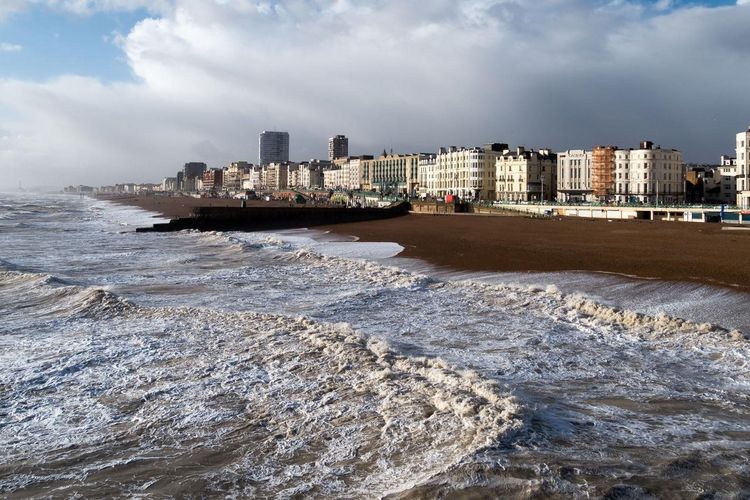
Brighton seafront, southern England © Francesco Carucci / age fotostock
- It all starts at the Royal Pavilion...
- Practical information
- The Theatre Royal, a cultural institution in Brighton
- Practical information
- Jubilee Square, a contemporary version of Brighton
- North Laine, Brighton's trendy district
- Practical information
- The charming maze of Lanes
- Practical information
- The church of Saint-Barthélémy, an architectural curiosity
- Practical information
- The Volks Electric Railway, the little train on the beach
- Practical information
- Practical information
- Saint Nicholas Church, Brighton's oldest monument
- The Palace Pier, an amusement park on Brighton's pier
- Practical information
- Practical information
- The aquatic world at Sea Life Brighton
- Practical information
- How do I get to Brighton?
It all starts at the Royal Pavilion...
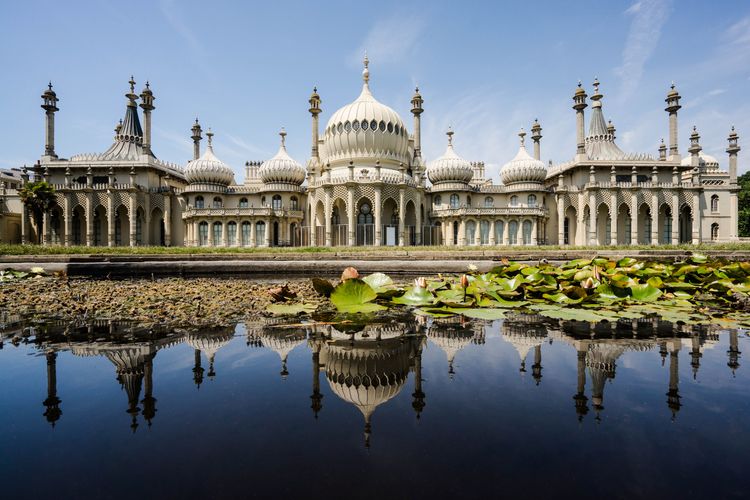
Brighton's extravagant Royal Pavilion
- © Patchamol Jensatienwong / ShutterstockThe building was originally a small farmhouse rented by George IV, then Prince of Wales, around 1780, when Brighton became a fashionable resort for the wealthy. With a flamboyant personality, betraying his childhood education and an interest in women, gambling and drink, he had it converted into a villa by the architect Henry Holland and decorated in Chinese style.
After becoming king, George IV had the building enlarged, this time by John Nash, who spared no expense. The Royal Pavilion remained the residence of monarchs until Queen Victoria, and then housed a hospital for Indian soldiers during the First World War.
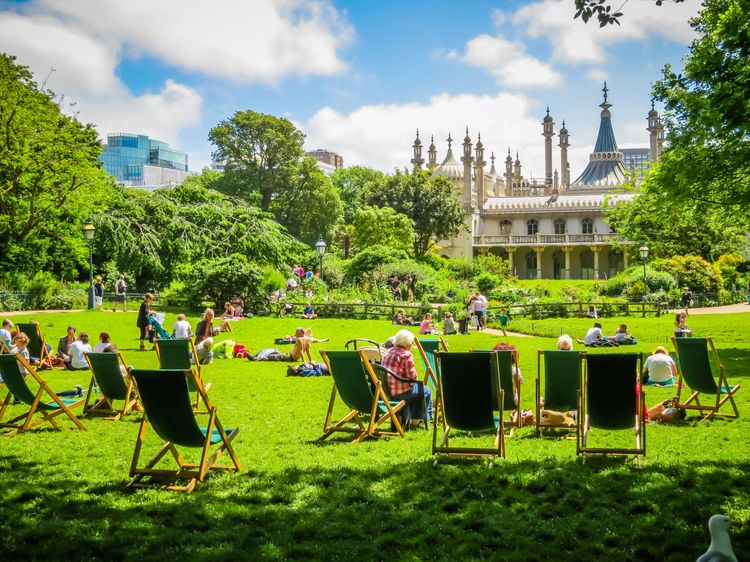
The Royal Pavilion gardens
- © Arndale / Shutterstock"When the sun comes out, why not take your picnic basket and stretch out on the grass against the backdrop of George IV's extravagant fantasy?"
Now fully restored, it is open to the public who can admire, among other things, the Banqueting Hall, the Royal Chambers and the Indian Military Hospital Gallery. Don't forget the Dome, located on the former site of the pavilion's stables.
Practical information
*Visit the Royal Pavilion : *
- Opening times: April-September 9.30am-5.45pm; October-March 10am-5.15pm
- Admission: adults £17; children (aged 5-18) £10.50; family 1 adult and 2 children £27.50; family 1 adult and 2 children £44.50
Admission: on site or online at Brighton & Hove Museums
The Theatre Royal, a cultural institution in Brighton
Located on New Road, a fairly new pedestrian avenue, amidst shops, restaurants and bars, Brighton's Theatre Royal is the oldest of its neighbours.

The facade of Brighton's Theatre Royal
- © DimplePatel / ShutterstockWhen theatre became a fashionable pastime in the early nineteenth century, George IV granted a royal warrant for the building of a new theatre in 1806, which opened only 10 months later for a performance of Hamlet with Drury Lane star Charles Kemble.
It endured a long and stormy period of instability, but the situation improved when Henry John Nye Chart, a mediocre actor, took over management in 1854, and the Theatre Royal became a leading cultural venue outside London. After his death 22 years later, his wife took control of the theatre, which saw all the great actors of the day tread its boards. Figures such as Noel Coward and Terence Rattigan also tried out their plays here before bringing them to London.
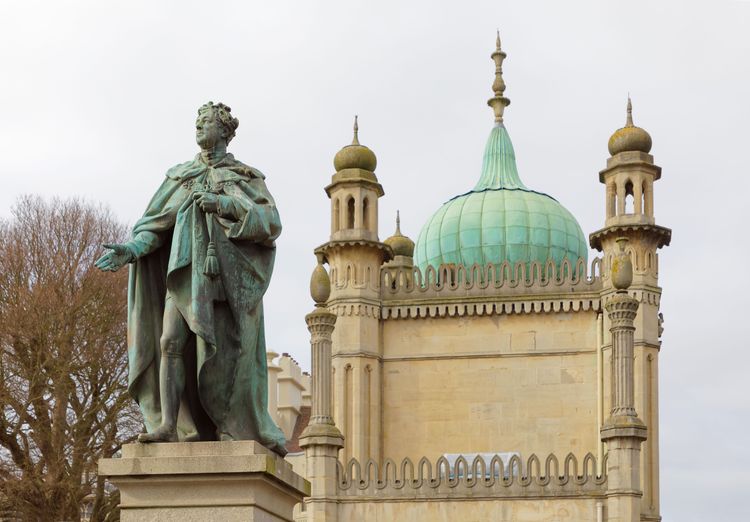
Statue of George IV in Brighton
- © Hans Christiansson / ShutterstockToday, audiences can still enjoy plays, concerts and one-man shows in the magnificent Regency-style auditorium, one of the oldest working theatres in the country.
Practical information
Attend a performance at Brighton's Theatre Royal:
Find the Theatre Royal programme and buy your tickets on the ATG Tickets website.
Jubilee Square, a contemporary version of Brighton
Jubilee Square represents one of the contemporary faces of Brighton and is the centrepiece of a regeneration project in the heart of the city, just off North Laine. Built on the site of a derelict multi-storey car park, it is now an urban area centred on an outdoor public meeting place.
"During our fortnight in Brighton, we saw children singing along to songs on a specially designed stage, couples of all ages dancing to the tunes of the 1950s and a book market with stalls selling both second-hand books and the latest releases."

Jubilee Square and its Library in Brighton
- © cktravels.com / ShutterstockAdjacent to the square is the ultra-modern Jubilee Library, praised for its award-winning design and environmental credentials. While the façade is inspired by Brighton's historic buildings, with its hand-glazed dark blue and green ceramic tiles, the interior is reminiscent of 19th-century Parisian libraries.
The area also boasts a number of restaurants, some of which have their own terrace right on the square, ideal for an al fresco lunch when the weather is sunny. It's also a great place to base your Brighton luggage.
 England
England
Supercity Apparthotel Brighton
Charming hotel in BrightonNorth Laine, Brighton's trendy district
Just next to Jubilee Square and the new face of Brighton begins the North Laine district. Occupying the one-and-a-half kilometre stretch between the station and the Royal Pavilion, it takes its name from the series of five open fields ("laines" in English) that once stood outside the old town. As the population grew, so did the demand for goods, which was met by the North Laine industries.

Dans le quartier de North Laines, Brighton
- © cktravels.com / ShutterstockAfter a sharp decline in activity during the Second World War, North Laine became a protected area that has since developed. The area is now home to 350 businesses, including shops, restaurants and cafés, and is the antithesis of the usual high streets, offering an atmosphere that seems to be infectious.
Teeming with independent shops, most of which are owner-operated, you'll find absolutely everything in this fairly small space, from Gresham Blake 's bespoke menswear to To Be Worn again and vegetarian restaurants such as Wai Kika Moo Kau.
Practical information
And don't forget the flea markets, the most famous of which is Snooper's Paradise, a veritable treasure trove with 90 stalls selling absolutely everything and anything!
The charming maze of Lanes
Bounded by North Street to the north, East Street to the east, Prince Street to the south and Ship Street to the west, the Lanes occupy what was once the heart of the fishing village of Brighthelmstone.

Le décor typique des Lanes à Brighton
- © travellight / ShutterstockThe district is defined by its picturesque, narrow, winding streets, which, like North Laine, are home to a multitude of independent boutiques, restaurants and cafés. A little more upmarket and commercial than North Laine, many antique dealers and jewellery designers (whose studios are usually located above the shop) have set up shop here, making it an ideal place to find an original souvenir to take home.
As well as luxury shops and designer boutiques, you'll find plenty of pubs, like the Bath Arms (one of the original Lanes' oldest licences) and places to grab a bite to eat, especially around Brighton Square, to watch the passers-by.
Practical information
"The only 'lane' that doesn't date from the late 18th century is Dukes Lanes, built about 25 years ago."
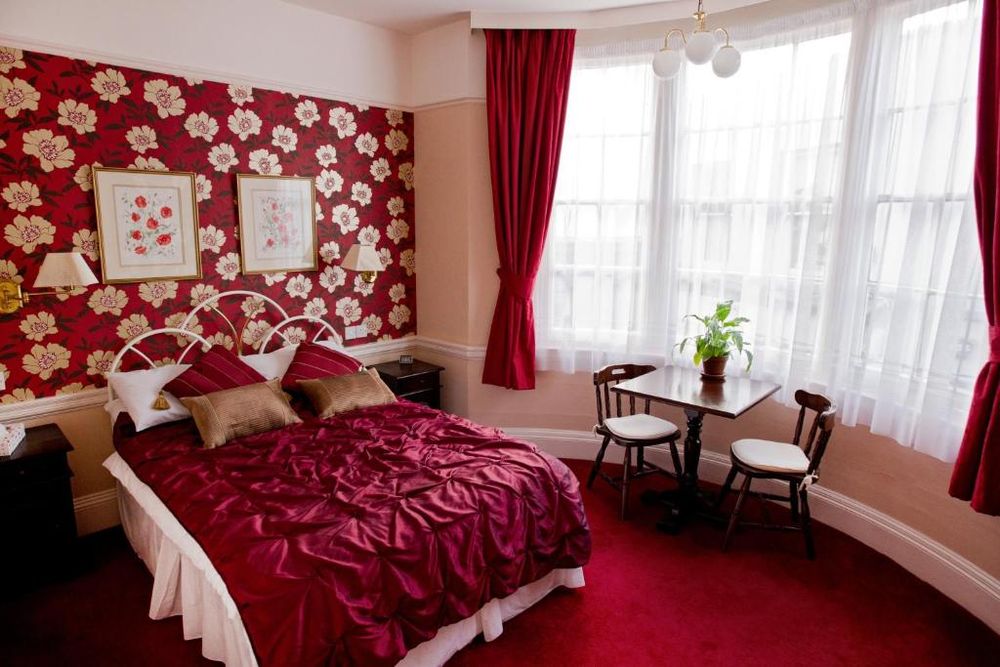 England
England
The Market Inn Brighton
Charming hotel in BrightonThe church of Saint-Barthélémy, an architectural curiosity
The imposingChurch of SaintBartholomew is located just outside the centre of Brighton, in Ann Street, between the station and the New England area. It was built between 1872 and 1874 to the designs of a little-known architect, Edmund Scott, a Londoner living in Brighton who was responsible for several other churches in the area, although none equalledSt Bart's.

The nave of Saint-Barthélémy church
- © Hert Niks / ShutterstockThe interior of this brick-built Italo-Gothic church was designed by Henri Wilson, a British architect and designer who played a central role in the Art and Crafts movement of the late 19th century. His contribution can be seen in the Byzantine baldachin, the marble pulpit and the silver altar. The building has no real annexes or partitions, which emphasises the height of its unique and spacious nave.
Practical information
Visit St Bartholomew's Church in Brighton:
- Services start at 12.15pm during the week and at 9.30am on Saturdays. On Sundays, a family mass is held at 9.30am and a solemn high mass takes place at 11am.
- The listed building is open to visitors from 10am to 1pm and from 2pm to 4.30pm, Monday to Saturday.
The Volks Electric Railway, the little train on the beach
Running along the seafront between the Aquarium and Black Rock on the marina, the Volks Electric Railway (VER) is the oldest working electric railway in the world. It was designed in 1883 by Brighton inventor Magnus Volk, the son of a German watchmaker, although the original track only covered 400 metres.
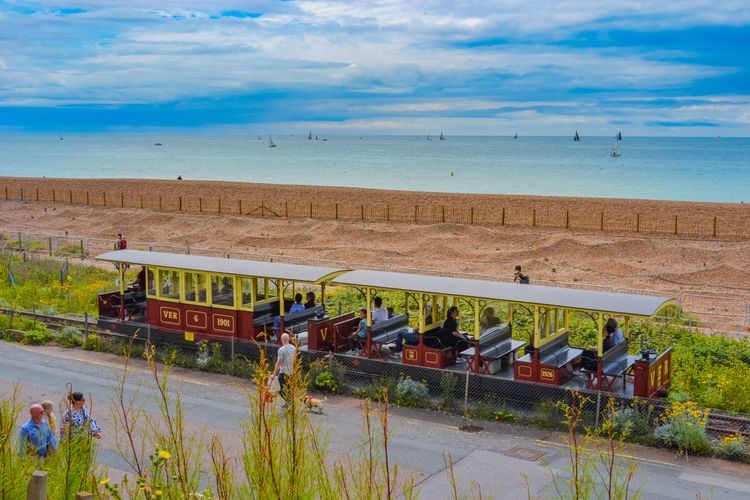
Le Volks Electric Railway de Brighton
- © Delia_Suvari / ShutterstockVolk was the first Brighton resident to have electricity in his home and also introduced the first telephone service in the city. His most audacious project, however, was the elusive 'Daddy Longlegs', an extension to the existing track, which saw a tram operating at 7 metres above sea level, with rails underwater.
Practical information
"For an authentically British seaside experience, buy a 99 flake (an ice cream) from the kiosk next to the ticket office and board a piece of history!"
Still in operation today, the VER is the ideal way to get around the seafront, especially as there are no buses on the route. This real family attraction is used by locals and tourists alike, and is still very affordable!
Practical information
*Take the VER to Brighton: *
The Volks Electric Railway runs from April to October. Several stations line the beach. Tickets can be purchased locally.
Saint Nicholas Church, Brighton's oldest monument
St Nicholas, the patron saint of sailors and fishermen, gave his name to Brighton's oldest parish church, St Nicholas Church. The oldest reference to this church dates back to 1085, with William the Conqueror's Domesday Book. This means that a church did exist at the time of the Norman Conquest, even if its current architecture dates from the 14th century.
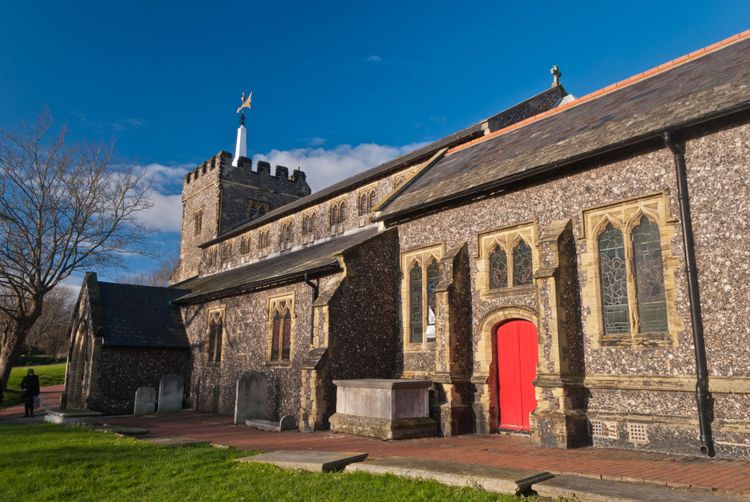
St Nicholas Church
- © DeepGreen / ShutterstockThe church's oldest surviving feature is its façade, which is thought to have been hewn from Caen stone around 1160. The church is Brighton's oldest surviving building, and would have been the church of the small fishing village of Brighthelmstone (Brighton's former name) as well as the first thing sailors saw as they approached the town's chalk cliffs.
The exterior is built of brushed stone and tiny pebbles from the beach, bound in lime mortar, while the interior was redesigned by Richard Carpenter in the mid-nineteenth century.
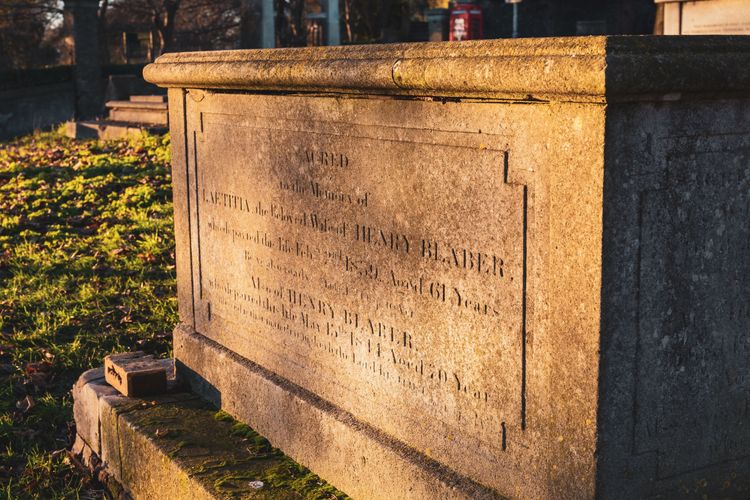
The cemetery adjacent to Saint-Nicolas church
- © eyematter / ShutterstockThe cemetery contains the graves of some of Brighton's most important figures, including Sake Dean Mahomed, who introduced baths to the town's seafront where the Queens Hotel now stands and was George IV's shampoo manufacturer. Admiral Sir Francis Laforey, captain of HMS Spartan with Nelson at the Battle of Trafalgar, is also buried here.
The Palace Pier, an amusement park on Brighton's pier
When it was built in the late nineteenth century, Brighton Marine Palace and Pier (its full name) was unlike any other pier in the UK. Opened in 1899 and completed in 1901, it included dining rooms, smoking and reading rooms and a concert hall.
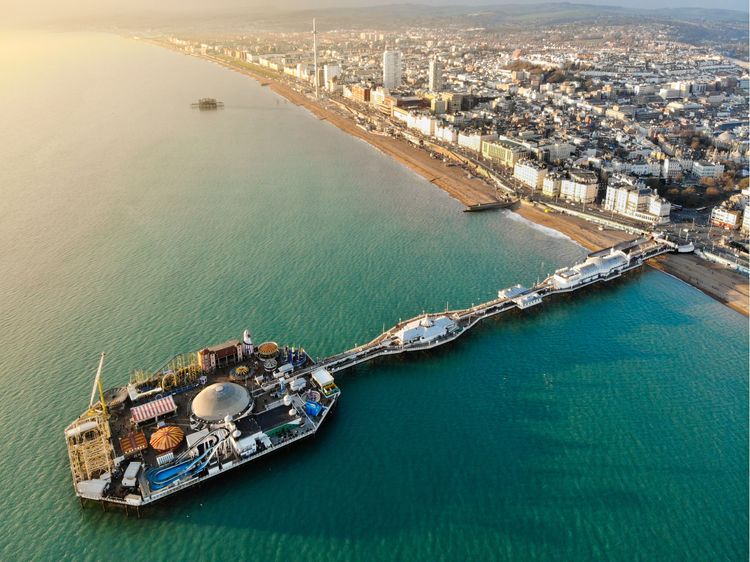
Aerial view of the Palace Pier
- © Stephen Green-Price / ShutterstockA few years later, a theatre was added, which was very popular but was partly destroyed in the 1970s following an accident and was never restored, despite the promises of its owners at the time. The pier was also home to a bandstand and a winter garden, although the landscape has changed a great deal today.
Practical information
"Although it is now more commercial than it was during its golden age, admission to Palace Pier is still free."
You'll find the traditional British seaside attractions with the tin can pyramids, the huge arcade with every kind of machine imaginable and, of course, the funfair with the famous Super Booster with passengers soaring through the air at nearly 100mph!
"The Pier wouldn't be the Pier without its fish & chips, bars and souvenir shops, which also sell the town's famous sweets, Brighton Rocks."
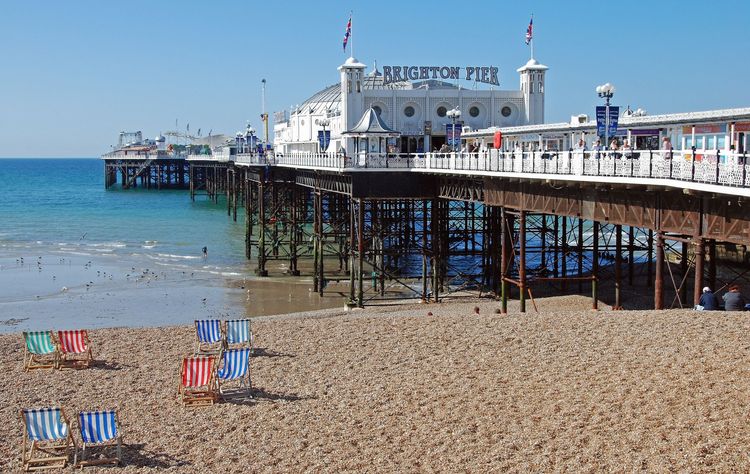
Palace Pier entrance
- © Peter Wooton / ShutterstockPractical information
- Opening times: Monday to Friday, 11am-6pm, weekends 10am-7pm
- Free admission
- More information on the Brighton Palace Pier website
The aquatic world at Sea Life Brighton
On the seafront, at the terminus of the Volks Electric Railway, is one of Brighton's most famous attractions. Although it is now owned by the Merlin entertainment company, Sea Life Brighton is the oldest aquarium in the world. It was built in 1872 by Eugenius Birch, who also designed the West Pier, and much of its Victorian architecture is still visible, giving it an old-fashioned charm.
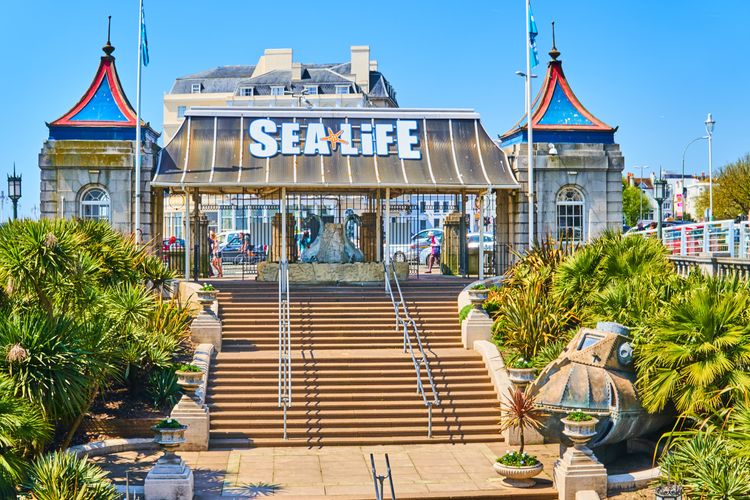
Sea Life, Brighton's aquarium
- © Michaelasbest / Shutterstock"Our visit began with the submarine adventure, a journey into the depths of the ocean aboard the Victorian Explorer, complete with videos and vibrant seating!"
Inside the exhibition proper, you'll discover numerous species of fish, some of which you'll recognise, such as the catfish and triggerfish, and others you're sure to meet for the first time, such as the pig-nosed turtle, the giant Japanese spider crab and the impressive spotted carpet shark.

The jellyfish ballet at Sea Life Brighton
- © Laura Theoff / ShutterstockOther sections include Lost in Amazonia, home to piranhas and other creatures found in the jungle; Serpents of the Sea, with a yellow moray eel; and of course the Ocean Tunnel, where you can walk around and admire tropical fish, sharks and turtles swimming above you.
The aquarium has just introduced a glass-bottomed boat for a closer look at the wonders of the ocean.
Practical information
- Opening times: April-July and September-October 10am-5pm; August 9.30am-6pm; November-March 10am-4pm
- Admission: on site £24.50; book at least 2 days in advance £18; free for under 3s
- Bookings on the Sea Life Brighton website
How do I get to Brighton?
Brighton is very easy to get to, especially from London. Trains leave from a number of London stations, including St. Pancras (the Eurostar terminus), Victoria and London Bridge. The city is also easily accessible from Gatwick airport, 45 minutes away by train. Nearby, the port of Newhaven offers ferry services to Dieppe and northern France.






